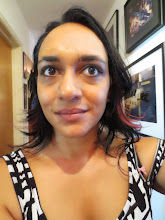Neighborhood Public Radio's Whitney Biennial Stream
The NPR storefront is only one Biennial outpost this year. Several artists' work has been installed in the Park Avenue Armory. A series of performances that will run until March 23 had not yet begun when I visited, but the grand and decaying architecture is spectacular and worth a visit in itself. A few of the installations are strong enough to make an impact on this overwhelming environment. They include The Scarface Museum by Mario Ybarra, Jr., commemorating the fictional gangster's appeal to young Chicanos in his home of Los Angeles who too often follow their hero to his downfall; and Ties of Protection and Safekeeping by Portland, Oregon-based performance artist M.K. Guth.
M.K. Guth, Ties of Protection and Safekeeping, 2007-2008. Braided fabric and artificial hair
Architecture stakes its claim on the Biennial in more than one place this year. LA artist/architect Fritz Haeg's Animal Estates surround the museum's exterior. These habitats for wild creatures - few of whom are likely to be found on Madison Avenue any longer - endeavor to bring animals back into the urban environment by offering them viable living spaces. At the same time, they read as a poke in the eye to the high-rent Upper East Side, offering luxury accommodations for bobcats, bald eagles and brown bats.
Fritz Haeg, Animal Estates 1.0: New York, New York, 2008
Inside the museum, the highlights include Javier Tellez' powerful film, Letter on the Blind For the Use of Those Who See, in which six blind men encounter an aged elephant and describe the wonder of getting up close to this powerful, gentle being, while ruminating on their experiences in a sighted world. Mika Rottenberg's environmental video installation Cheese tells the story of six sisters who claimed to milk a hair-growth tonic from their own exceptionally long hair. The story plays out wordlessly on several screens embedded within a tattered wooden structure, the decrepit form of which contrasts with the sunny, high-quality production values of the accompanying videos.
Javier Tellez, Letter on the Blind For the Use of Those Who See, 2007. 16mm film transferred to high-definition video, color, sound; approximately 35 min.
Walead Beshty presents images of the abandoned Iraqi Diplomatic Mission in East Berlin, a site where the remnants of two collapsed regimes intersect in their neglect. The large-scale prints are themselves expressionless, except for a gentle colored glow which is the chance result of X-ray exposure. Adler Guerrier invents a long-dead political movement, "BLCK," addressing real history through fictional documentary. The artifacts he creates call our attention to true events that took place in Miami 1968, which have been forgotten by many these forty years later.
This being a Whitney Biennial, there's also plenty to hate, but fortunately there's enough to love that the show yet again warrants a visit.

No comments:
Post a Comment